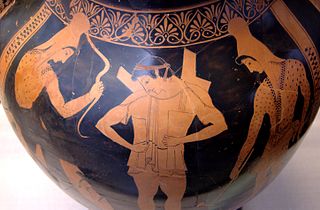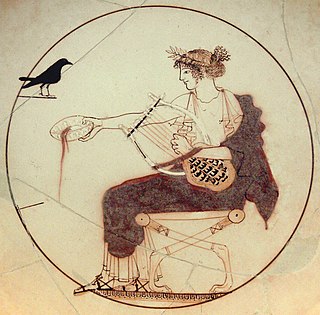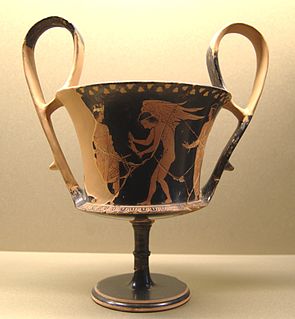
Ancient Greek pottery, due to its relative durability, comprises a large part of the archaeological record of ancient Greece, and since there is so much of it, it has exerted a disproportionately large influence on our understanding of Greek society. The shards of pots discarded or buried in the 1st millennium BC are still the best guide available to understand the customary life and mind of the ancient Greeks. There were several vessels produced locally for everyday and kitchen use, yet finer pottery from regions such as Attica was imported by other civilizations throughout the Mediterranean, such as the Etruscans in Italy. There were a multitude of specific regional varieties, such as the South Italian ancient Greek pottery.

Black-figure pottery painting, also known as the black-figure style or black-figure ceramic, is one of the styles of painting on antique Greek vases. It was especially common between the 7th and 5th centuries BC, although there are specimens dating as late as the 2nd century BC. Stylistically it can be distinguished from the preceding orientalizing period and the subsequent red-figure pottery style.

Red-figure vase painting is one of the most important styles of figural Greek vase painting.
The Kleophon Painter is the name given to an anonymous Athenian vase painter in the red-figure style who flourished in the mid-to-late 5th century BC. He is thus named because one of the works attributed to him bears an inscription in praise of a youth named "Kleophon". He appears to have been originally from the workshop of Polygnotos, and in turn to have taught the so-called Dinos Painter. Three vases suggest a collaboration with the Achilles Painter, while a number of black-figure works have also been attributed to him by some scholars.

Euphronios was an ancient Greek vase painter and potter, active in Athens in the late 6th and early 5th centuries BC. As part of the so-called "Pioneer Group,", Euphronios was one of the most important artists of the red-figure technique. His works place him at the transition from Late Archaic to Early Classical art, and he is one of the first known artists in history to have signed his work.

Euthymides was an ancient Athenian potter and painter of vases, primarily active between 515 and 500 BC. He was a member of the Greek art movement later to be known as the Pioneer Group for their exploration of the new decorative style known as red-figure pottery. Euthymides was the teacher of another Athenian red-figure vase painter, the Kleophrades Painter.

Lydos was an Attic vase painter in the black-figure style. Active between about 560 and 540 BC, he was the main representative of the '’’Lydos Group’’’. His signature, ό Λυδός, ho Lydos ", inscribed on two vases, is informative regarding the cultural background of the artist. Either he immigrated to Athens from the Lydian empire of King Kroisos, or he was born in Athens as the son of Lydian parents. In any case, he learned his trade in Athens.

Epiktetos was an Attic vase painter in the early red-figure style. Besides Oltos, he was the most important painter of the Pioneer Group. He was active between 520 BC and 490 BC. His name translates as "newly acquired", which is most probably a reference to his slave status.

Psiax was an Attic vase painter of the transitional period between the black-figure and red-figure styles. His works date to circa 525 to 505 BC and comprise about 60 surviving vases, two of which bear his signature. Initially he was allocated the name "Menon Painter" by John Beazley. Only later was it realised that the artist was identical with the painters signing as "Psiax".

The Pioneer Group is a term used by scholars for a number of vase painters working in potters' quarter of Kerameikos in ancient Athens around the beginning of the 5th century BC, around the time of the emergence of red-figure vase painting, which soon displaced the previously dominant black-figure style.

White-ground technique is a style of white ancient Greek pottery and the painting in which figures appear on a white background. It developed in the region of Attica, dated to about 500 BC. It was especially associated with vases made for ritual and funerary use, if only because the painted surface was more fragile than in the other main techniques of black-figure and red-figure vase painting. Nevertheless, a wide range of subjects are depicted.

The Kerch style, also referred to as Kerch vases, is an archaeological term describing vases from the final phase of Attic red-figure pottery production. Their exact chronology remains problematic, but they are generally assumed to have been produced roughly between 375 and 330/20 BC. The style is characterized by slender mannered figures and a polychromatism given to it by the use of white paint and gilding.

The Amasis Painter was an ancient Greek vase painter who worked in the black-figure technique. He owes his name to the signature of the potter Amasis, who signed twelve works painted by the same hand. At the time of the exhibition, "The Amasis Painter and His World" (1985), 132 vases had been attributed to this artist.

The Shuvalov Painter was an Attic vase painter of the red-figure style, active between 440 and 410 BC, i.e. in the High Classical period.

The Painter of Berlin A 34 was a vase painter during the pioneering period of Attic black-figure pottery. His real name is unknown, his conventional name derived from his name vase in the Antikensammlung Berlin. He is the first individual vase painter of the style in Athens recognised by scholarship. His works are dated to circa 630 BC. Two of his vases were discovered in Aegina. Since the 19th century, those pieces were on display in Berlin, but they disappeared or were destroyed during the Second World War.

The KX Painter was an Attic black-figure vase painter. He was active between 585 and 570 BC. Besides the KY Painter, the KX Painter was the main representative of the Comast Group, which succeeded the Gorgon Painter. His conventional name was allocated by John Beazley. He is considered the better and chronologically somewhat earlier representative of the group. He was the first painter in Athens to occasionally depict komasts on his vases, a motif adopted from Corinthian vase painting. He mainly painted skyphoi, lekanes, kothones and Komast cups. In contrast to later representatives of the group, he still mostly painted animals, in a more careful and powerful style than the Gorgon Painter. Some mythological scenes by him are also known. Especially famous are his small-fornat mythical scenes placed within animal friezes. The KX Painter can be considered the first Attic painter to achieve a quality at par with that reached in Corinth, then the dominant centre of Greek vase painting. Imitations of his works are known from Boeotia.

The Leagros Group was a group of Attic black-figure vase painters active during the last two decades of the 6th century BC. The name given to the group by modern scholars is a conventional one, derived from a series of name vases.

The Rycroft Painter was an Attic late black-figure vase painter, active in the final decade of the sixth century BC. His real name is not known.

Skythes was an Attic black-figure and red-figure vase painter active between about 520 and 505 BC.

Etruscan vase painting was produced from the 7th through the 4th centuries BC, and is a major element in Etruscan art. It was strongly influenced by Greek vase painting, and followed the main trends in style over the period. Besides being producers in their own right, the Etruscans were the main export market for Greek pottery outside Greece, and some Greek painters probably moved to Etruria, where richly decorated vases were a standard element of grave inventories.



















